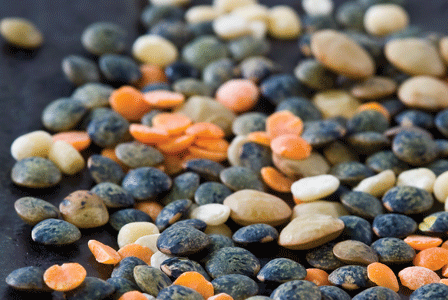
Although often forgotten in the discussion of superfoods, lentils are filled with health benefits and can be worked into recipes with delicious results.
Although often forgotten in the discussion of superfoods, lentils are a nutritional fountain of youth and can be worked into a number of comforting dishes with delicious results.
It’s hard to find a reason why you shouldn’t eat plenty of lentils, given their inherent earthy, vitamin-laden yumminess. Still skeptical? Here are nine reasons why you should load up on these unsung heroes of the bulk bins.
1. Trim your waistline: one cup (250 mL) of cooked lentils contains a mere 230 calories, 1 g of fat, and a whopping 16 g of dietary fibre. On top of keeping you more regular than Norm from Cheers, several studies suggest that those who consume the most fibre are more likely to tip the scale in the right direction. Fibre slows digestion and tends to fill you up, taking a sledgehammer to hunger pangs.
2. Slash cholesterol: a 2010 European Journal of Nutrition study reported that subjects who consumed four servings per week of cooked chickpeas, beans, peas, or lentils for two months experienced improvements in cholesterol levels. Lentils are sky-high in soluble fibre. As soluble fibre enters the digestive tract, it absorbs water and dissolves into a viscous gel that reduces the absorption of cholesterol into the bloodstream.
3. Drop blood pressure: lentils are abundant in potassium. A study of more than 17,000 adults in the Archives of Internal Medicine reported that higher potassium intakes are associated with significantly lower blood pressure numbers. High blood pressure is a leading risk factor for stroke.
4. Dodge diabetes: when Canadian scientists reviewed data from 41 studies, they determined that consuming a diet rich in lentils can lead to long-term improvements in blood sugar numbers and a lower risk for diabetes. Lentils can lower the overall glycemic index of the diet, resulting in fewer blood sugar spikes.
5. Fight cancer: very few foods contain more folate than mighty lentils. In addition to helping prevent birth defects, this B vitamin has been shown to confer protection against several forms of cancer including pancreatic, colon, and bladder. The body uses folate to properly form and replicate DNA, and researchers believe low levels could contribute to cancer by making genetic mutations more likely.
6. Boost energy: lentils are chockablock with iron, which is necessary for the delivery of oxygen from the lungs to the brain and muscles. So coming up short can leave you lethargic with brain fog.
7. Budget protein: with 18 g of protein per cup and costing only about $1.50 per pound from bulk bins, lentils are a frugal protein alternative to beef, chicken, and fish.
8. Antioxidant punch: when we think of antioxidants, what comes to mind is luminous fruits and vegetables, but it turns out lentils contain an abundance of antioxidants, according to an International Journal of Food Science & Technology study. Antioxidants help mop up cell-damaging free radicals that initiate several chronic diseases.
9. Get dinner on the table faster: unlike their bean counterpart, lentils don’t require an annoying pre-soak and they cook in half the time.
All dried up
Although it’s tempting to opt for more convenient canned lentils, dried lentils have much better flavour and texture. Canned lentils often come with high sodium numbers and are packed in tins coated with bisphenol A (BPA). A 2010 study reported that US adults with high urinary concentrations of BPA are more likely to develop heart disease and diabetes.
Pick over dry lentils before cooking them to remove any small stones that can land you in the dentist chair. Then rinse and place them in a pot with roughly 2 1/2 to 3 cups (625 to 750 mL) of water or broth for each cup of lentils.
To avoid overcooking firmer lentils, start tasting after about 15 to 20 minutes. Lentils for salads should be less mushy than those meant for soups.
When cooking, it’s best to avoid non-enameled cast-iron or aluminum cookware because these materials tend to slow cooking and adversely alter the colour of the lentils. Add salt and acids such as vinegar, wine, tomatoes, or lemon juice only after the lentils are tender as these can lengthen cooking time by hardening the lentils.
Cooked lentils can be stored in the refrigerator for up to one week or in an airtight container in the freezer for six months.
Recipes
- Apple Lentil Muffins
- Curried-Lentil Quinoa Loaf
- Lentil Tapenade
- Roasted Butternut Lentil Soup
Lentil lexicon
Lentils come in a variety of hues, all worth exploring.
|
Name |
Description |
Great in |
| Beluga lentils |
firm and chewy with a strong earthy flavour; glistens like beluga caviar once cooked |
roasted root vegetable medleys, braised cabbage dishes, salads |
| Brown/green lentils |
mild, meaty flavour and slightly chewy texture |
lentil and vegetable soups, casseroles, salads, stews, veggie burgers |
|
French green lentils |
rich, peppery flavour; stay firm when cooked | salads, tabbouleh, pilafs |
| Red lentils | nutty and slightly sweet; commonly used in Middle Eastern or Indian food dishes; disintegrate easily when cooked | Indian dals, baked goods, creamy soups, spreads |
| White lentils (ivory lentils) |
mild taste and soft texture; these are skinned and split black lentils | stews, soups, casseroles |
| Yellow lentils |
slightly nutty flavour; don’t hold their shape when cooked |
Indian dals, curry and squash soups, spreads, baked goods |

